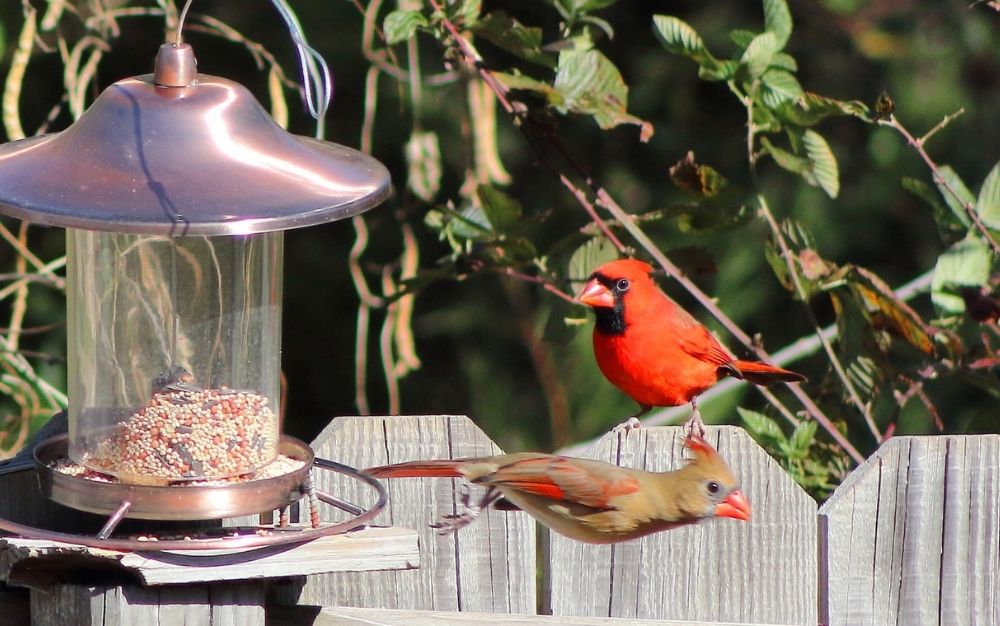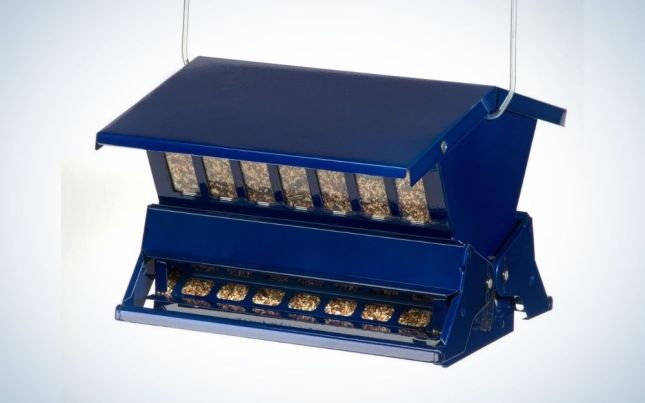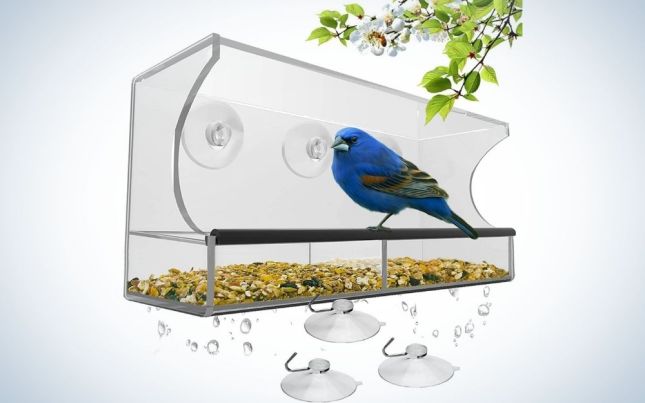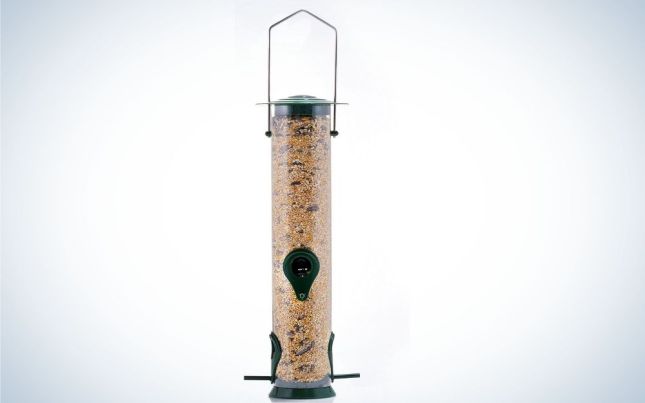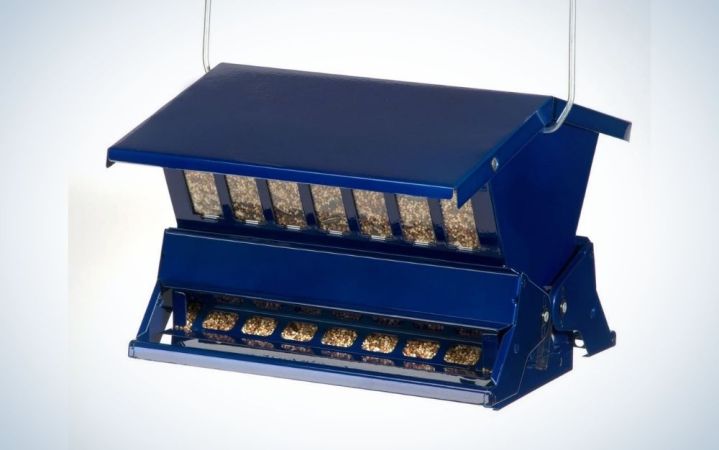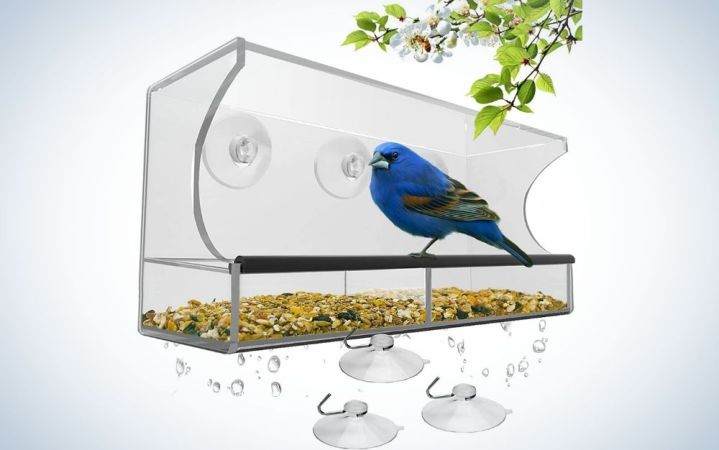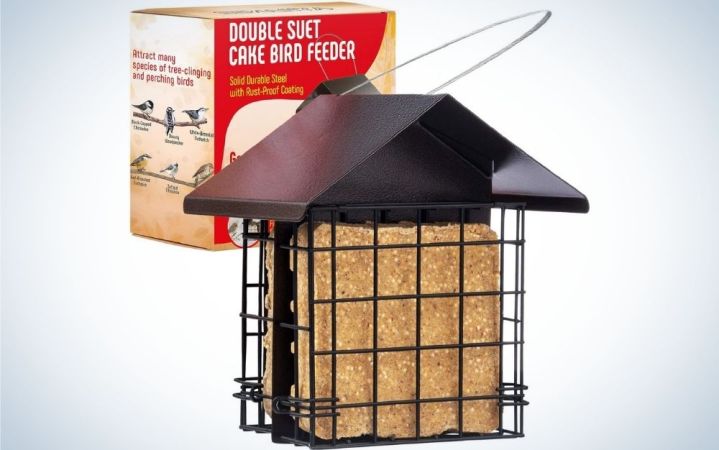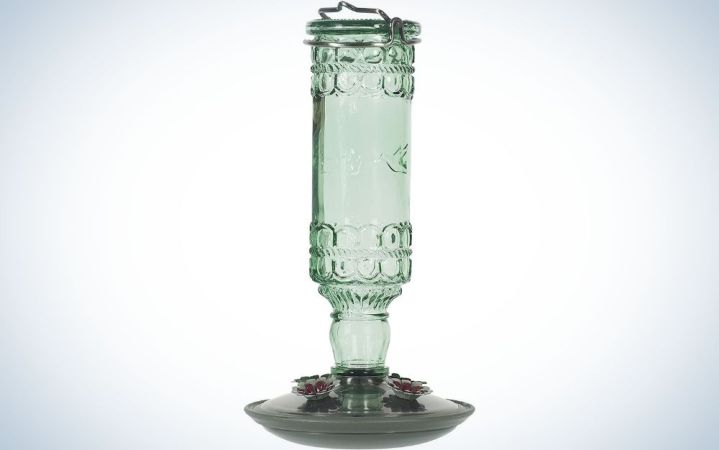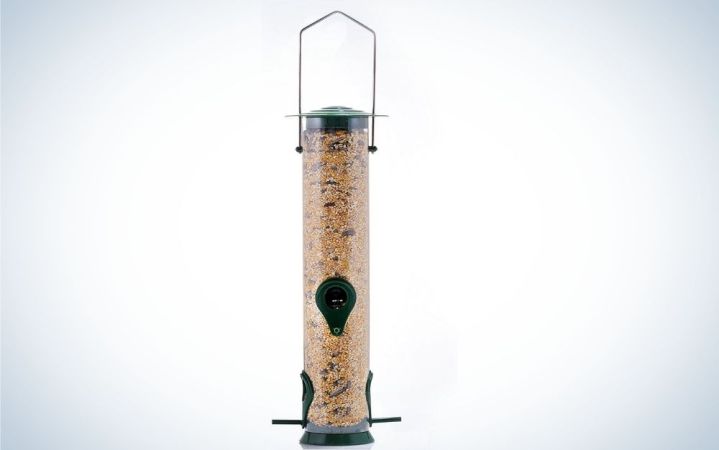We may earn revenue from the products available on this page and participate in affiliate programs. Learn More ›
The U.S. Fish and Wildlife Service says more than 45 million people bird watch, either at home or in the field. One of the simplest ways to do that is to install unique bird feeders. The best bird feeders are designed to bring a wide variety of birds to your yard and ensure ample bird watching with minimal fuss.
- Best Squirrel-Proof Bird Feeder: Heritage Farms Squirrel-Resistant Feeder
- Best Window Bird Feeder: Nature’s Hangout Window Bird Feeder
- Best Suet Feeder: Suet Cake Bird Feeder
- Best Hummingbird Feeder: Antique Bottle Hummingbird Feeder
- Best Budget Bird Feeder: Gray Bunny Tube Feeder
The Best Bird Feeders, Then and Now
Today, the best bird feeders are usually specialized to meet the unique needs of the local wild bird community. or to deal with problems like birdseed spilling or squirrel activity at the hanging bird feeder.
The history of bird feeders begins with homemade measures, such as nailing carcasses and suet to a tree. Others recommended filling coconuts or tin cans with seeds.
Commercial bird feeders began to roll out in the early 1900s and looked remarkably similar to the best bird feeders on the market today. These early models included window feeding trays that served as window bird feeders, and bird bells that were designed to minimize waste by preventing the bird feeder from spilling.
Options available today take bird feeders to the next level, providing simple options to attract unique species and minimize annoyances so that more people can simply enjoy seeing various species of birds in their backyards.
Squirrel Resistant Bird Feeders
One of the first considerations when it comes to choosing the best bird feeder for you is something utterly non-bird: squirrels. Squirrels are drawn to bird feeders, and since they’re more dexterous than birds, they can be destructive, wasting birdseed and scaring off the birds you’re hoping to watch.
There are three basic strategies for addressing this common issue. The first is to choose a squirrel proof bird feeder. Squirrel-proof bird feeders come in a wide range of designs, including caged feeders, feeder poles with baffles, and spring action bird feeders designed to snap shut based on the weight of the squirrel. The latter is also efficient at minimizing large birds that may be aggressive toward smaller birds.
The second strategy is to focus on the bird feed. Squirrels love nuts, fruit, sunflower seeds, and corn, so avoid using those in bird feeders prone to squirrel visits. Good squirrel-resistant bird feed includes nyjer seed, safflower seed, and white proso millet. You can also purchase bird feed coated in capsaicin—the compound that makes hot peppers burn your tongue—or simply mix some cayenne pepper into your seeds. Capsaicin only affects mammals, so it will drive away squirrels without bothering the birds.
Finally, consider setting up a separate squirrel-feeding station. Pairing an easy-access squirrel feeder some distance from the bird feeder, and loading it with squirrel-approved goodies like sunflower seeds, corn, and peanuts will make the more challenging bird feeder less attractive to local squirrels.
Best Squirrel Proof Bird Feeder: Heritage Farms Squirrel-Resistant Feeder
Clever Design
Heritage Farms’ all-metal, squirrel-resistant bird feeder has adjustable, spring-activated perches that snap the feeder closed when a squirrel climbs on. It holds up to 12 pounds of birdseed for less frequent filling.
Location, Location, Location: Where to Place Hanging Bird Feeders
Picking the best place for hanging bird feeders can be tricky. On the one hand, hanging bird feeders near trees gives birds some cover and places to rest while they are feeding. The downside of that setup is that it makes it easier for squirrels to hop onto the feeder or for roving cats to pounce.
It may come as a surprise that one of the best places to hang a feeder is also ideal for bird watching. Setting up a window bird feeder—or simply hanging a feeder within 3 feet of a window—is a safety precaution. Millions of birds die every year after colliding with window glass. Installing a window bird feeder ensures that birds will approach (or leave) the window at lower speeds, preventing deadly collisions.
Best Window Bird Feeder: Nature’s Hangout Window Bird Feeder
Sturdy Construction
This window bird feeder uses powerful suction cups to secure the feeder to any window for unobstructed viewing. The easy-to-clean design includes drain holes to keep the birdseed fresh.
Suet Feeders for Winter Bulk
For most of the year, wild birds get tons of protein by eating insects. Birds have super fast metabolisms, so they are an important part of their diet. Winter is another story. When the temps drop, many insects migrate, overwinter, or hibernate, so wild birds have a harder time tanking up.
Suet feeders are a simple way to provide a dense source of energy to wild birds. This is essentially a cake of animal fat and birdseed that’s traditionally hung in a cage-like feeder so wild birds can peck at the seeds and fat. Bird watchers interested in drawing in smaller birds should consider an upside down suet feeder, which is more difficult for larger, more aggressive birds to use.
And don’t put away your suet feeder when spring comes! These feeders can hold other goodies, such as fruit treats or nesting materials to encourage wild birds to nest in your yard.
Best Suet Feeder: Suet Cake Bird Feeder
Versatile Design
Step up your bird-feeding game with a suet feeder. This one is rust-resistant and holds two suet cakes—or suet on one side and nesting materials on the other.
Spotlight on Hummingbird Feeders
When it comes to bird watching, hummingbirds are no doubt popular subjects—and they have special feeding needs. Hummingbirds use their long beaks to drink nectar from flowering plants. Hummingbird feeders provide supplemental nectar that helps wild hummingbirds thrive even when native nectar sources are low or haven’t yet bloomed.
While it’s true that hummingbirds are drawn to red—because they associate the color with high quality nectar—it’s not really a good idea to feed hummingbirds dyed red hummingbird food, which may cause health problems. A homemade clear sugar solution in a 1:4 sugar to water ratio is better. Simply boil this mixture then allow it to cool and fill up the hummingbird feeder.
Because homemade sugar solutions can spoil, it’s important to hang the hummingbird feeder in the shade. Ideally, the feeder should also be in a location protected from wind so the feeder doesn’t spill.
Best Hummingbird Feeder: Antique Bottle Hummingbird Feeder
Vintage Look
The antique-style design of this hummingbird feeder is adorable and easy to clean. It holds 10 ounces of nectar and features four flower-shaped, red-colored feeding ports to attract hummingbirds.
Budget Bird Feeders: What You Get for Less Than $8
While specialized bird feeders may be ideal for dealing with problems like squirrels or meeting the needs of unique bird species, there’s no reason that a bird feeder should break the bank. Even hanging up homemade suet-and-birdseed cakes will bring wild birds to your yard for satisfying bird watching.
It’s still a good idea to purchase an inexpensive hanging bird feeder rather than scattering birdseed on the ground. While scattering may attract wild birds, it can also put them in danger since birds on the ground are at a disadvantage against predators like free-ranging cats.
Look for a simple tube feeder that holds a good quantity of birdseed and has ports with perches for easy access. A tube feeder designed to be water resistant or weatherproof is a solid investment that will last season after season.
Best Budget Bird Feeder: Gray Bunny Tube Feeder
Water Resistant
This tube feeder is durable and weatherproof. It holds 4 cups of birdseed and has 4 ports with perches for easy access.
FAQs
When it comes to choosing whether bird feeders should be in the sun or shade, it’s a good idea to consider the preferences of the specific birds you hope to attract. In general, most birds prefer to feed in the sun while being protected from the wind. Ideally, hang the feeder in a sheltered area with southeastern exposure and an unobstructed view of the area so the birds feel safe from predators. Hummingbird feeders should be kept in the shade to prevent the nectar from spoiling quickly.
The best bird feeders for small birds make it easy for small birds to feed while discouraging larger birds that can be more aggressive. Tube feeders with small perches are a good choice. Suet feeders designed so the birds can feed upside down from beneath the feeder are also attractive to small birds.
The best squirrel-proof bird feeders keep squirrels out so birds can feed in peace—and prevent birdseed waste. Some squirrel proof feeders rely on a cage-like surrounding to keep squirrels out. Others have an adjustable, spring-action design so the feeder snaps shut when a squirrel shows up for a meal.
The Best Bird Feeders: A Investment in Bird Watching
Bird feeders provide two advantages: First, they allow you to get a close-up view of birds from inside your home. Second, they provide necessary nutrition to birds, which can be in short supply, especially during the winter months. Picking one shouldn’t be hard, so we’ve done the hard work for you.
